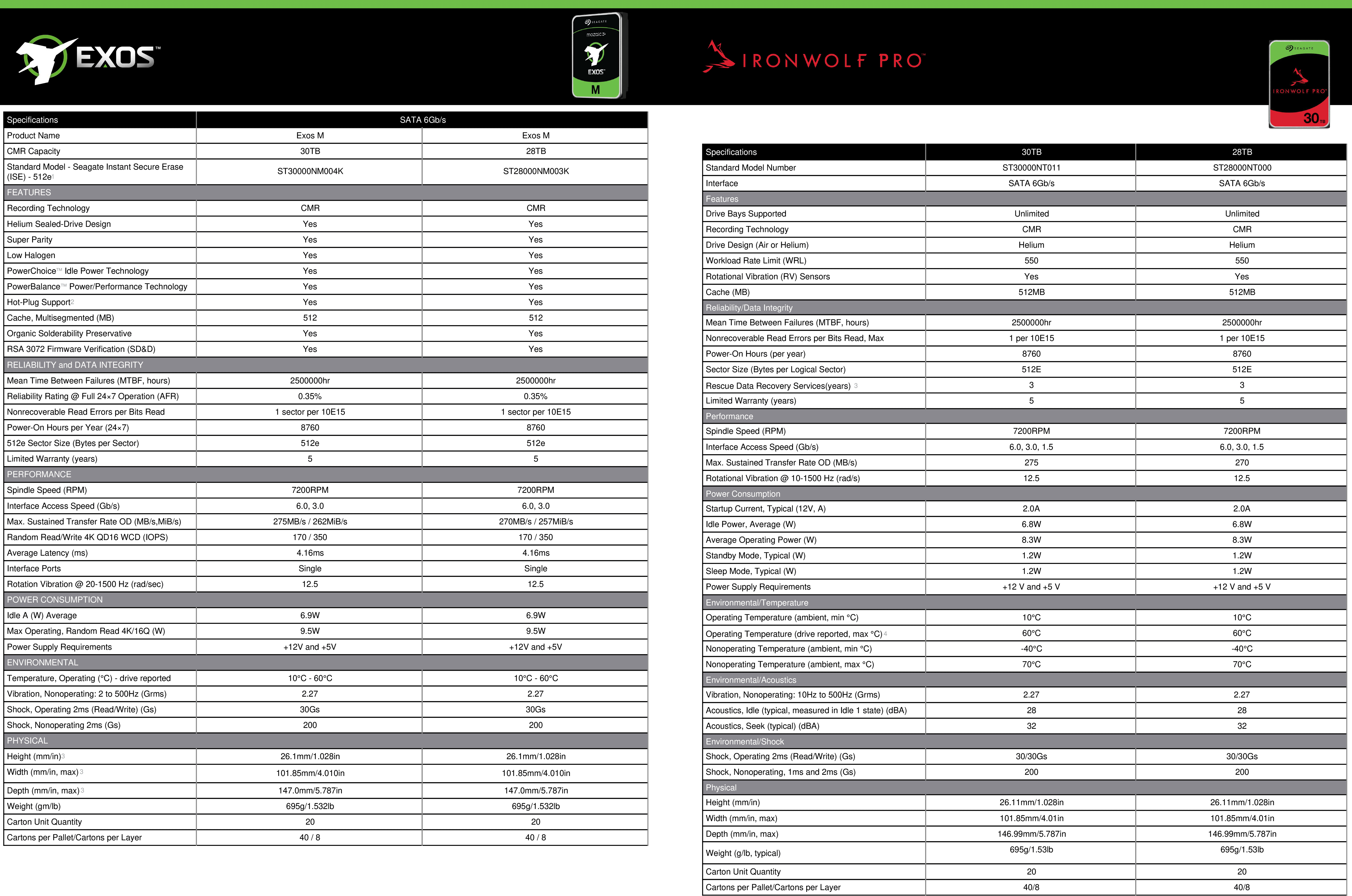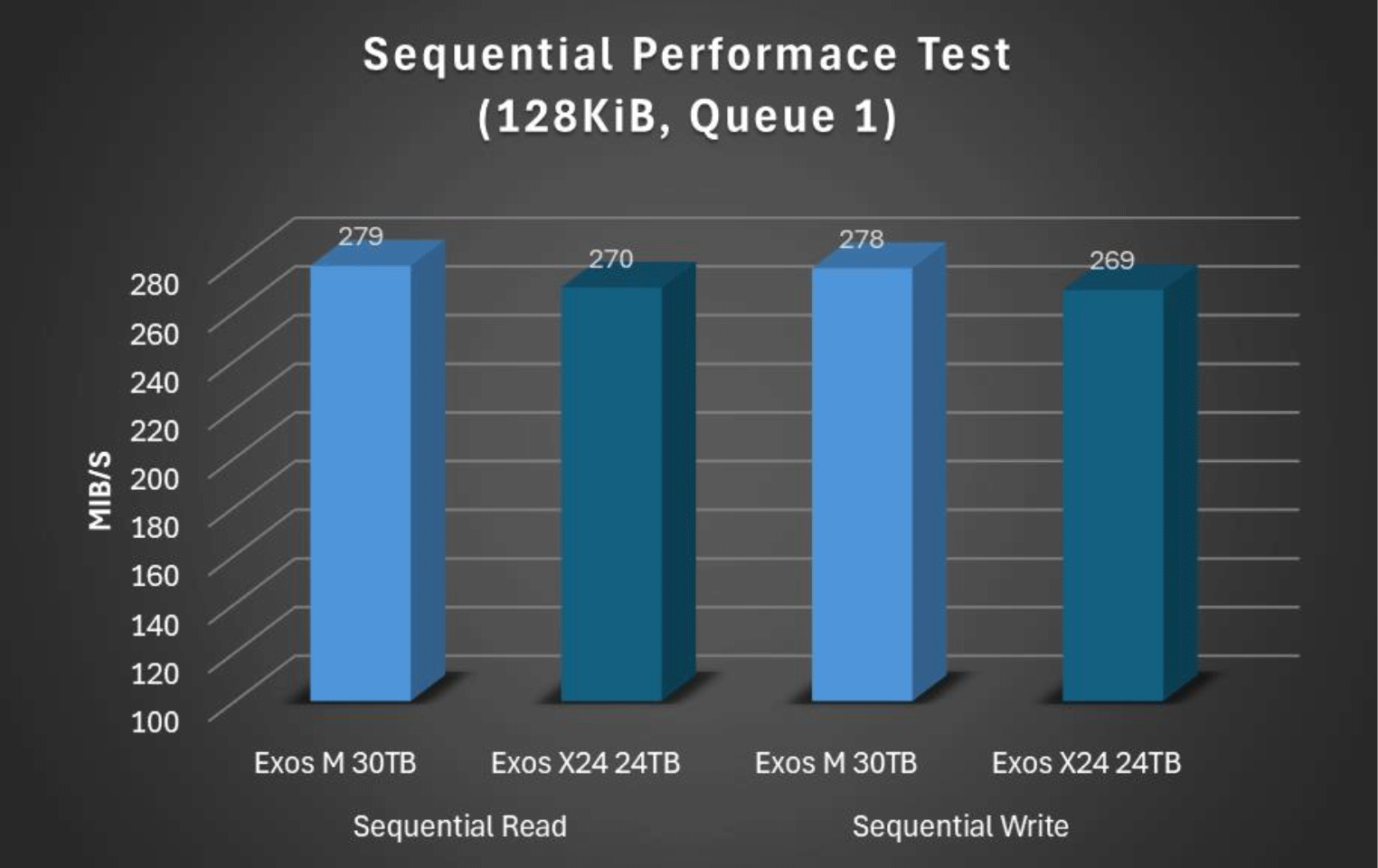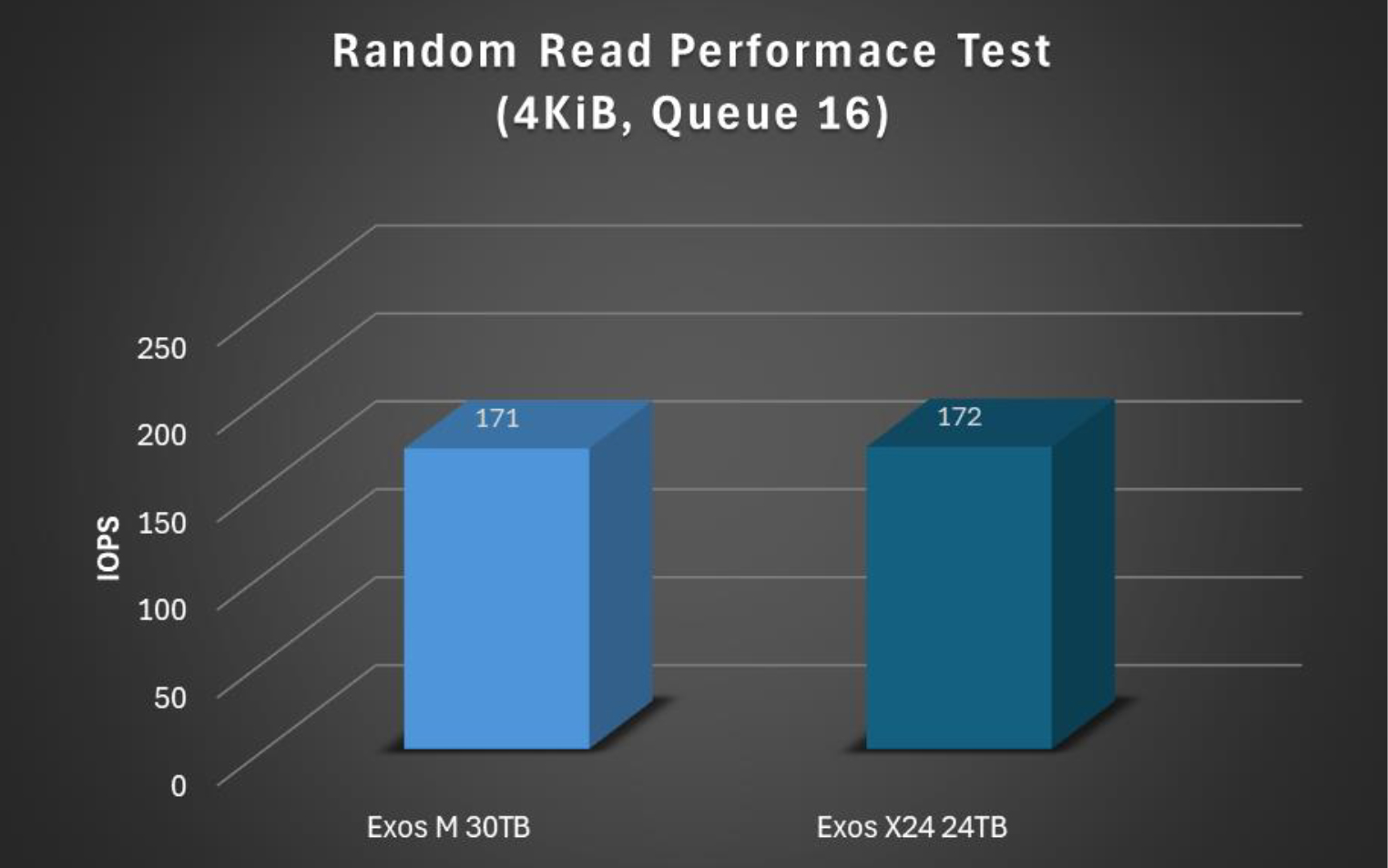Seagate unveils 30TB HAMR HDDs for the masses — laser-powered IronWolf Pro and Exos drives are now widely available
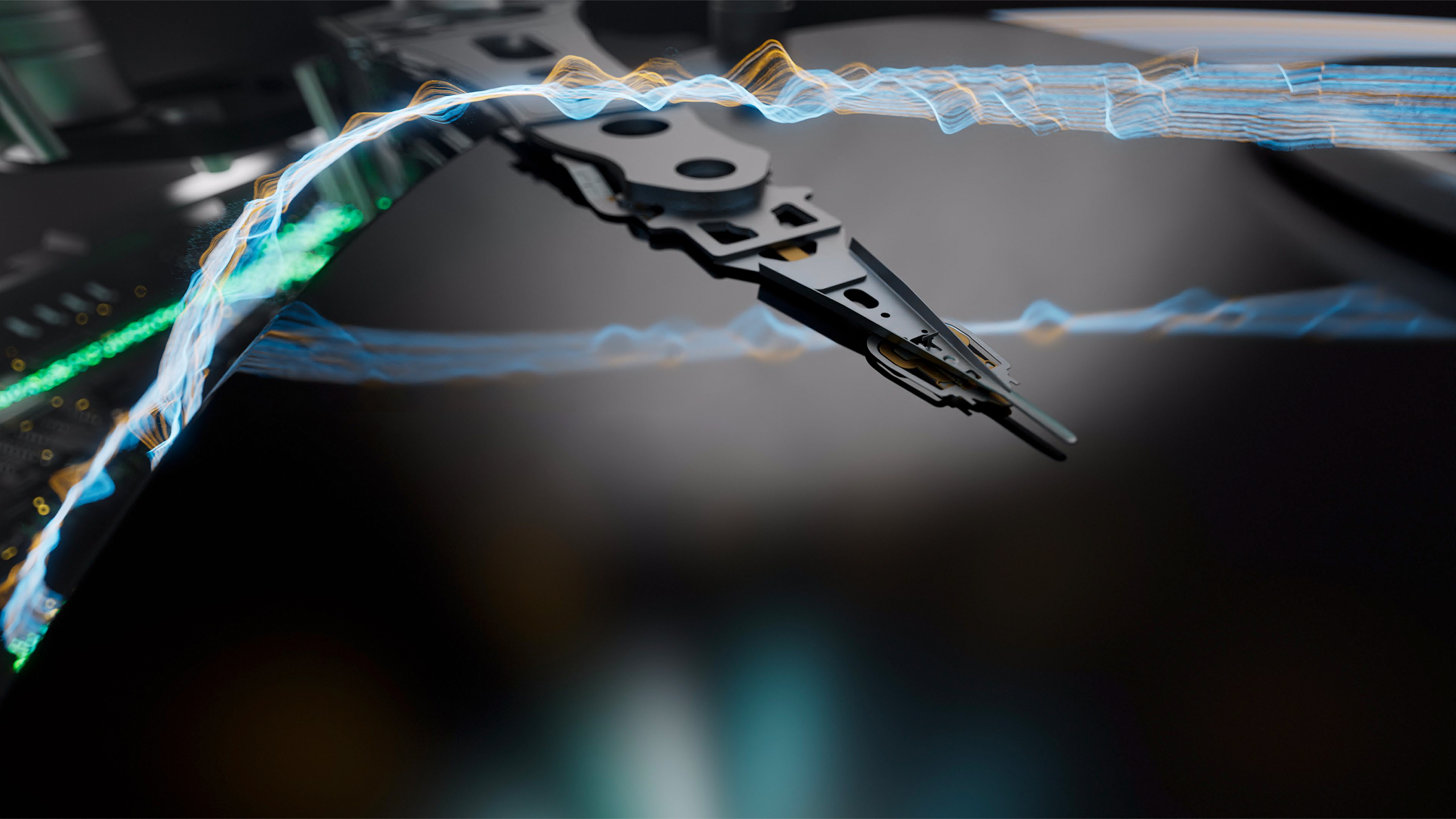
Today, Seagate introduced its Exos M 30TB and IronWolf Pro 30TB hard disk drives (HDDs), which utilize heat-assisted magnetic recording technology. This technology employs a laser to increase storage density. This is the first time Seagate has made HAMR HDDs based on its Mozaic 3+ technology available to the mass market, marking a significant milestone for both the company and the storage industry, which unleashes an unprecedented amount of storage density.
Seagate has also shared its in-depth performance benchmarking, which we've shared and analyzed below, highlighting strong performance trends for the new HAMR drives. Seagate's 30TB and 28TB versions of the Exos M and IronWolf Pro hard drives are now officially available globally through the Seagate online store and through the company’s network of approved resellers and distribution partners. Let's take a deeper look at the drives and Seagate's benchmarks.
New CMR capacity champions
New CMR capacity champions
Seagate’s Exos M 30TB and 28TB, as well as IronWolf Pro 30TB and 28TB hard drives, are built on the company’s Mosaic 3+ platform, which represents Seagate’s second-generation implementation of HAMR (heat-assisted magnetic recording). Unlike the first generation, which never reached the market, Mosaic 3+ is now commercially available.
To enable high-density writing, the drives are equipped with a specialized plasmonic writer subsystem featuring a vertically integrated nanophotonic laser. This laser heats a small spot on the FePT recording layer on the disk to approximately 450°C (842°F), altering its magnetic coercivity and allowing data to be recorded on the heated spot. Reading is handled by heads that use Gen 7 Spintronic Reader, which features multiple reading sensors to help mitigate signal interference between adjacent tracks, ensuring data can be read accurately even at very high track densities.
The new 30TB HDDs come in the industry-standard 3.5-inch form factor and operate at a rotational speed of 7,200 RPM, which is standard for enterprise-class performance hard drives to balance performance and power consumption. Yet, for those clients who need to alter consumption, Seagate's PowerChoice adjusts idle power consumption and PowerBalance technology enables balancing power consumption and IOPS (input/output operations per second) performance.
Additionally, the drives are equipped with a 512 MB multi-segmented cache. This multi-part buffer helps smooth data transfers and enhances performance during intensive read/write operations, particularly under burst workloads.
Speaking of performance, the drives feature 3TB platters with a rather unprecedented areal density, offering a maximum sustained transfer rate of 275 MB/s, approximately 5 MB/s higher than previous-generation drives. As for random performance, the HDDs are rated for up to 170/350 random read/write IOPS (4K, QD16), down from 170/550 random read/write IOPS in the case of the Exos X18 HDDs from a few years ago.
Get Tom's Hardware's best news and in-depth reviews, straight to your inbox.
Although Seagate's Exos M 30TB and IronWolf Pro 30TB have many similarities, they are formally designed for different applications. The former is designed for large-scale deployments in cloud and enterprise environments (specifically those used for AI), so it comes with numerous design enhancements to improve reliability and ensure predictable performance in highly-vibration environments, such as a top and bottom attached motor, RV sensors, and other means to reduce turbulence. By contrast, the latter are designed for use in NAS systems within commercial and enterprise environments, so the drive fully supports continuous operation in multi-bay and multi-user setups and is built to handle the stresses of modern workloads.
Compatible with existing storage systems: up to 36PB per rack.
Compatible with existing storage systems: up to 36PB per rack.
Seagate's new Exos M 30TB and IronWold Pro 30TB are the first HAMR-based HDDs that will be available in channel and retail markets, as previously the company only shipped such drives to select hyperscale customers who had qualified them beforehand. Being available to a broader range of clients is clearly a significant milestone for Seagate.
Both of Seagate's 30TB HDDs utilize conventional magnetic recording (CMR), ensuring compatibility with standard storage systems while increasing capacity. This tech also preserves as much performance as possible, unlike Shingled Magnetic Recording (SMR) technology.
In addition, the drives use a SATA 6 Gbps interface and consume 6.9W (average) – 9.5W (maximum), so they are drop-in compatible with existing storage systems, assuming that they can handle 30TB HDDs (which may not be the case with all NAS, for example).
A modern 4U storage server can accommodate up to 100 3.5-inch HDDs; thus, a fully equipped machine with Seagate's 30TB HDDs can store up to 3,000TB of data (3PB). Thus, the new hard drives enable the storage of from 30PB (42U rack) to 36PB (48U rack) per single rack, which is unprecedented storage density.
Exos M Performance
Exos M Performance
However, while Seagate's 30TB drives indeed increase capacity and storage density, they still offer roughly the same amount of performance as their predecessors, so the increased density doesn't come at the cost of performance in the most important types of workloads for HDDs. Below we have some of the performance tests conducted by Seagate, with the mixed workload results showing a clear advantage and highlighting the performance tuning for real-world applications.
The sequential read/write bandwidth (128 KiB, Queue 1) benchmark shows that both the Exos M 30TB and the Exos X24 achieve nearly identical peak read and write speeds, around 275 MB/s on the outer tracks. This indicates that the increased platter density in the Exos M does not compromise large-block sequential throughput. From a throughput-per-spindle perspective, both drives perform equally well, suggesting that Seagate maintained read/write head performance while increasing capacity.
In the 4 KiB random read benchmark at a queue depth of 16, the Exos M 30TB delivers roughly 171 IOPS, closely matching the Exos X24. Despite narrower tracks due to the denser media, the Exos M sustains equivalent read performance, implying that Seagate’s TDMR-based read heads effectively maintain signal quality and accuracy. This confirms that small-block read I/O does not degrade with the transition to HAMR and higher areal density.
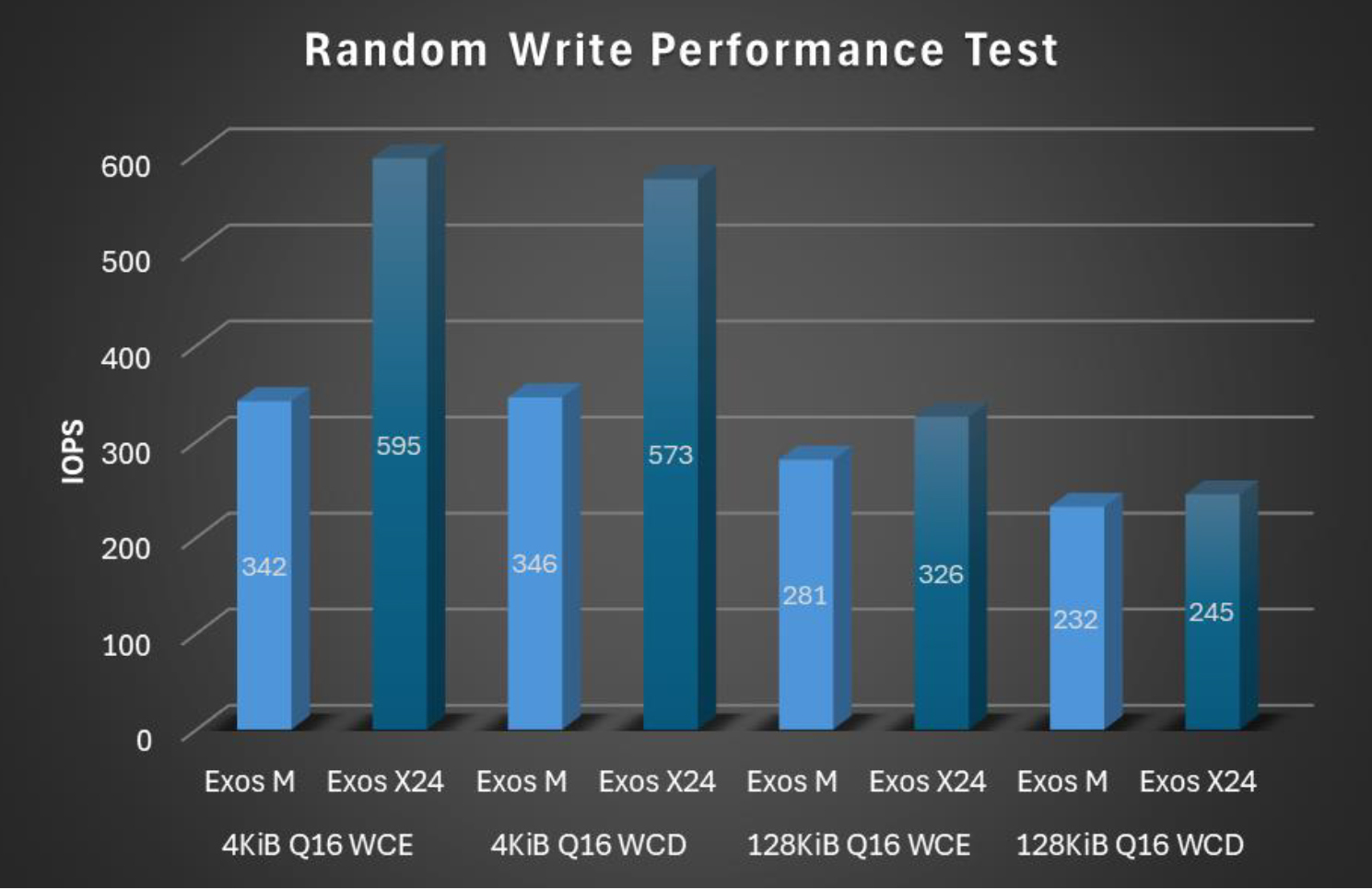
However, the 4 KiB random write performance reveals the only notable weakness in the Exos M, as it trails the Exos X24 significantly, achieving only about 346 IOPS at the same queue depth. This drop is consistent with known limitations of HAMR, such as more complex write calibration, which affects short-duration, high-frequency write operations. Nonetheless, the performance penalty appears specific to small-block writes, which is visible in this synthetic test but may not be noticeable in real-world workloads.
Keep in mind that nearline HDDs (such as the Exos M) are not exactly designed for small random writes — SSDs or caching mechanisms step in to satisfy those types of workloads, even in consumer NAS. For hard drives, random writes tend to occur at larger block sizes, such as the 128KiB size outlined in the same chart. In this workload, which is more representative of real-world conditions, we can see that the Seagate drive delivers nearly the same performance as its predecessor.
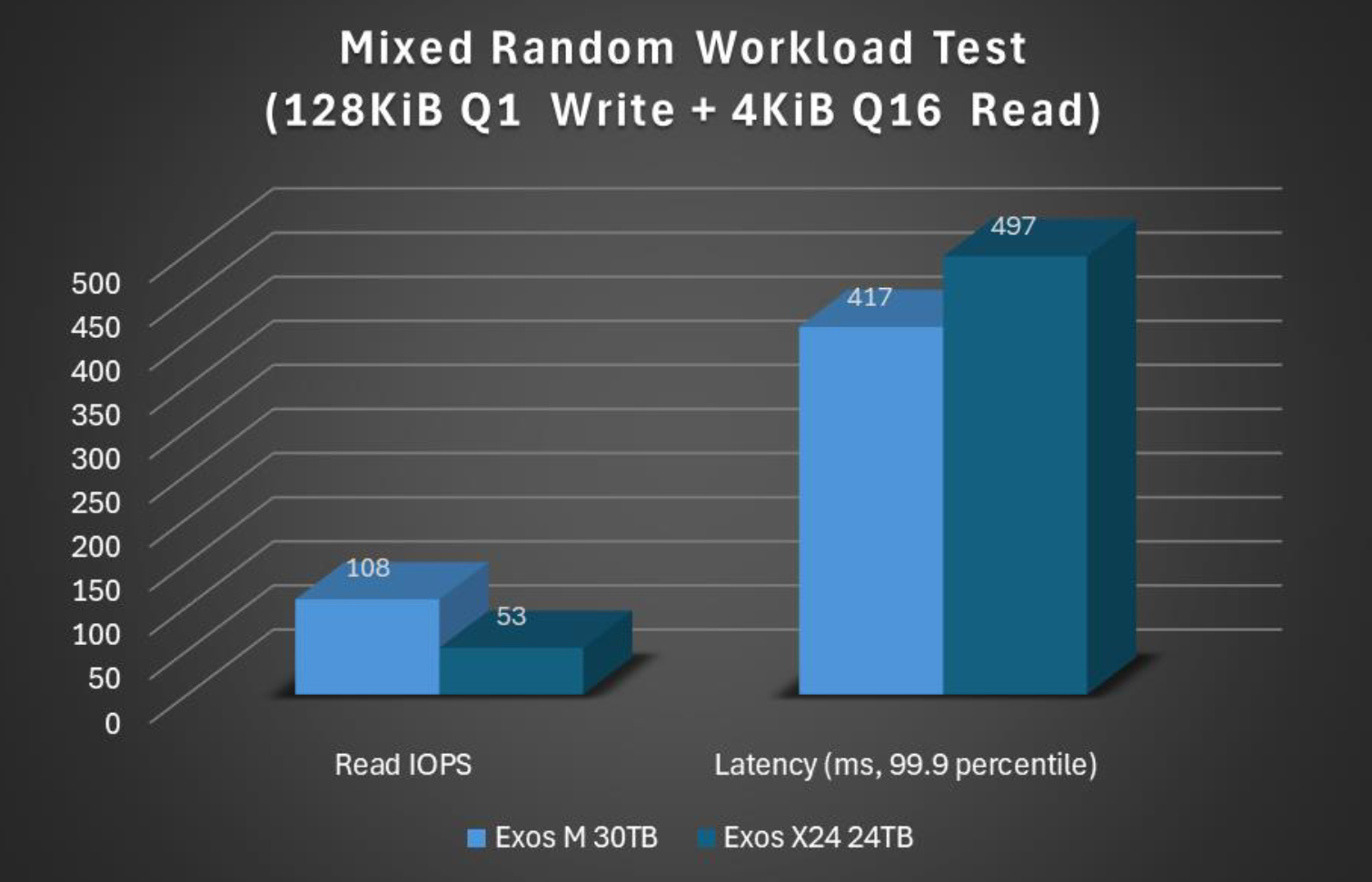
In the mixed-workload benchmark, which combines 128 KiB random writes (Q1) and 4 KiB random reads (Q16) with the write cache disabled, the Exos M demonstrates a clear advantage. It doubles the read IOPS of the X24 and shows reduced 99.9th percentile read latency. This suggests that the Exos M's architecture, specifically its segmented 512 MB cache and optimized read path, handles concurrent I/O more efficiently. This also clearly shows that Seagate has prioritized tuning for real-world hard drive usage scenarios.
What is perhaps more important is that sequential performance-per-TB and random performance-per-TB of the new HAMR-based 30TB HDDs are significantly lower compared to HDDs from several years back, but that is a natural and expected byproduct of the increased capacity. As a result, companies using these hard drives will mitigate this per-TB performance drop to maintain the quality of service in their data centers, often by augmenting the deployments with strategically placed flash-based caches.
IronWolf Pro Performance
IronWolf Pro Performance
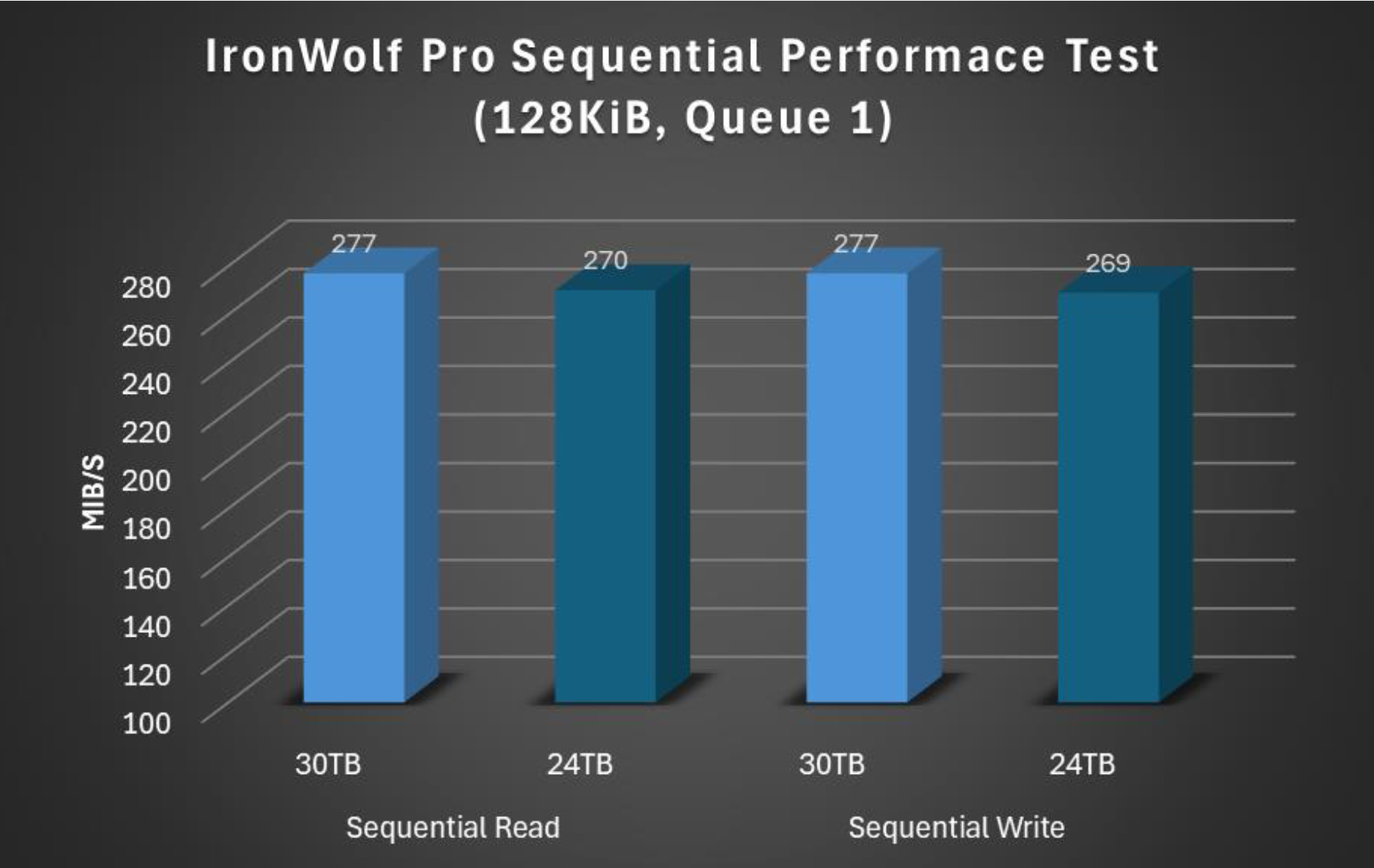
The performance of the 30TB IronWolf Pro generally mimics that of the 30TB Exos M. The new drive is slightly faster in sequential workloads (128 KiB, Queue 1), demonstrating a throughput of around 277 MB/s on outer tracks, which is slightly faster compared to its 24TB predecessor. This essentially means that the new HAMR-based drive for high-end NAS applications is largely equivalent to its predecessor.
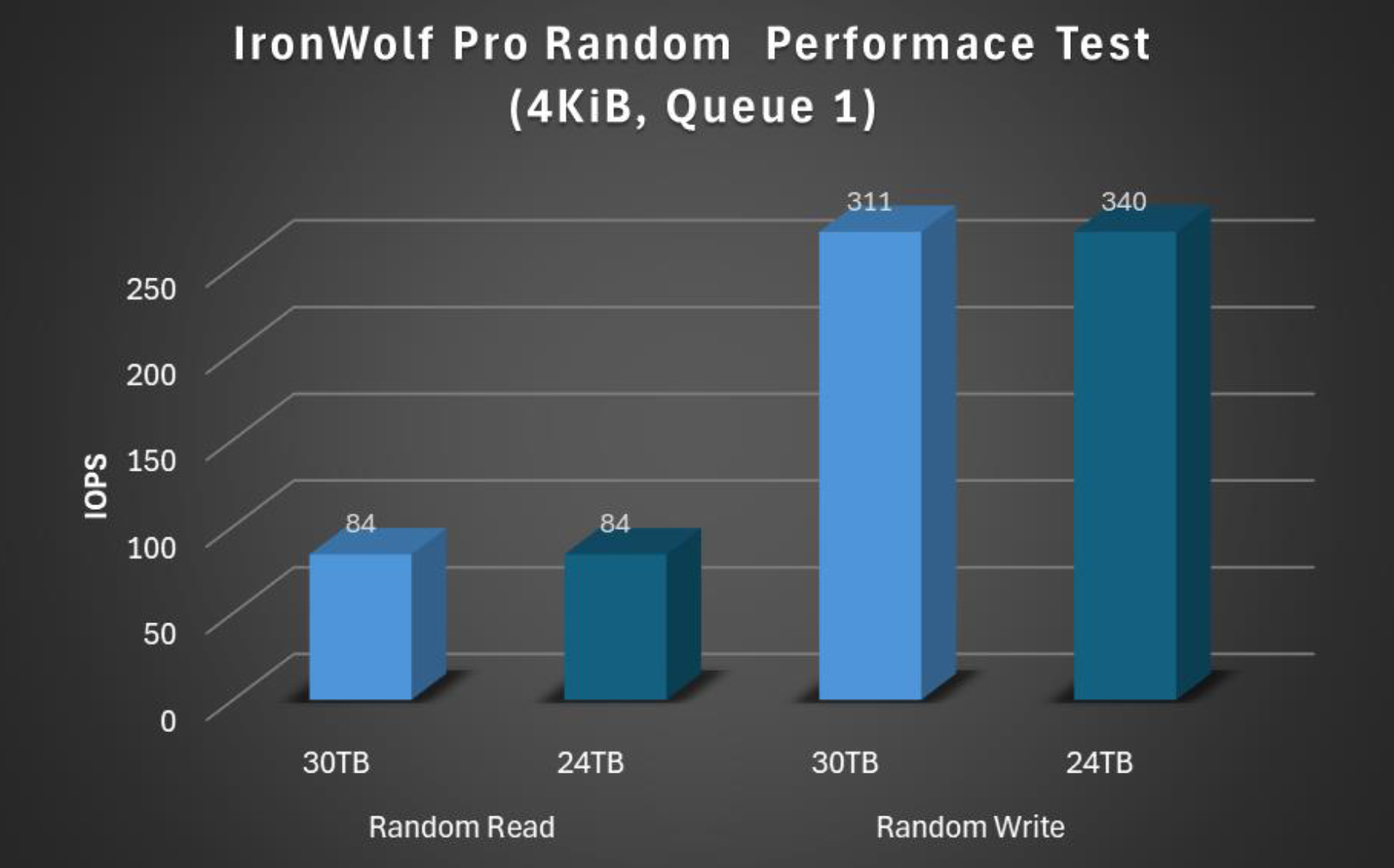
When it comes to random performance, random read IOPS are identical for both 24TB and 30TB HDDs at 84 IOPS, indicating no improvement in small-block read performance despite the 30TB’s higher platter density. However, again, random write IOPS show a slight drop for the 30TB model — 311 IOPS vs. 340 IOPS on the 24TB. This may again suggest slightly higher write latency caused by more complex write calibration on HAMR HDDs.
Availability
Availability
Seagate's 30TB and 28TB versions of the Exos M and IronWolf Pro hard drives are now officially available globally through the Seagate online store and through the company’s network of approved resellers and distribution partners. The listed retail prices are $599.99 for both the Exos M 30TB and IronWolf Pro 30TB models, and $569.99 for the 28TB variants of each drive.
Follow Tom's Hardware on Google News to get our up-to-date news, analysis, and reviews in your feeds. Make sure to click the Follow button.

Anton Shilov is a contributing writer at Tom’s Hardware. Over the past couple of decades, he has covered everything from CPUs and GPUs to supercomputers and from modern process technologies and latest fab tools to high-tech industry trends.
-
SomeoneElse23 I found the Exos M on NewEgg. Apparently Seagate only expects this drive to last only a year?? That's insane.Reply
NewEgg doesn't (yet) have the 30TB Pro, but the 20TB drive has a 5 year warranty, which is much more reasonable. -
DS426 "Thus, the new hard drives enable the storage of from 30PB (42U rack) to 36PB (48U rack) per single rack, which is unprecedented storage density."Reply
Unprecedented for HDD's, not for SSD's; 30 TB 2.5" SSD's are common now, some 60's are also available, and 120's have been developed and are coming to the market soon. 60 TB 2.5" SSD's filling a 1U rack = 2 PB, so a 48U rack can store 96 PB of data. -
mogster I think there's an error in the article. Instead of "4 KiB random write performance", the "4 KiB random read performance" graphic is shown twice.Reply -
lmcnabney Informative article, but $600 spinning rust isn't 'for the masses'. Especially with mediocre warranties.Reply -
SomeoneElse23 Reply
While true, if nothing else this will drive down prices of what-used-to-be larger drives.lmcnabney said:Informative article, but $600 spinning rust isn't 'for the masses'. Especially with mediocre warranties. -
A Stoner Reply
New Egg either has different warranties or they are not honest on what the warranty is. The documentation on Seagate says 5 year warranty. I saw the same thing with a 26 TB model recently. New Egg is $5 cheaper, but showed a 2 year warranty and Seagate showed 5 years.SomeoneElse23 said:I found the Exos M on NewEgg. Apparently Seagate only expects this drive to last only a year?? That's insane.
NewEgg doesn't (yet) have the 30TB Pro, but the 20TB drive has a 5 year warranty, which is much more reasonable. -
SomeoneElse23 ReplyA Stoner said:New Egg either has different warranties or they are not honest on what the warranty is. The documentation on Seagate says 5 year warranty. I saw the same thing with a 26 TB model recently. New Egg is $5 cheaper, but showed a 2 year warranty and Seagate showed 5 years.
Right you are. :( NewEgg is getting en****ified.
The Seagate website shows 5 year warranty. It also shows a 36TB model. -
Rob1C More interesting for some people is the USB version, for little more than half price.Reply
https://www.seagate.com/products/external-hard-drives/expansion-desktop-hard-drive/?sku=STKP6000400&store=1 -
leclod "Unlike the first generation, which never reached the market,"Reply
I own a 24TB Seagate drive with a laser warning on the label.
Maybe the first generation did reach the market -
JRStern >This laser heats a small spot on the FePT recording layer on the disk to approximately 450°C (842°F)Reply
Um, what's the number of times you can do that before it, uh, fails?
I guess the odds are on a 30tb drive it doesn't come up very often, ... but it might. Does it auto-remap every sector on rewrites to you don't wear it out?
